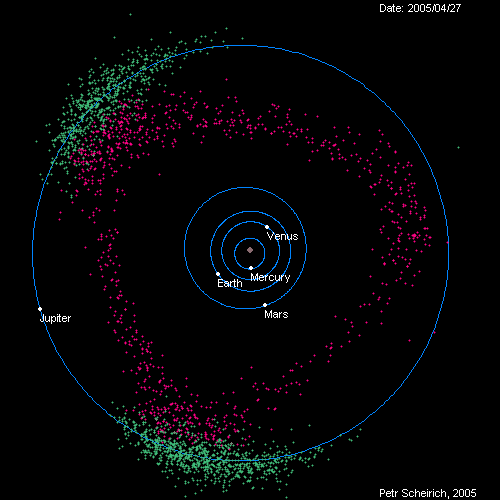Cassini Spacecraft Captured This Image Of Saturn And Titan

Cassini spacecraft captured this image of Saturn and Titan
More Posts from Starry-shores and Others

Ratnagiri petroglyph, India. 10,000 BC...





the red eyeshine of the alligator occurs when light enters its eyes, passes through the rods (light receptors) and cones (color receptors) of the retina, strikes a membrane behind the retina called a tapeatum, and is then reflected back through the eye to the light source. most of the animals with eyeshine are, like alligators, night hunters who must make use of limited light. photos by larry lynch and david moynahan
yeswe_travel
Look how littel I am, next to this massive mountain..
Can you see the beauty around me ✨ .
DE)
from Asimov’s ‘Nightfall’
Here’s a great explanation of language usage in sci-fi literature for all those who cannot keep their nit-picking to themselves:
Kalgash is an alien world and it is not our intention to have you think that it is identical to Earth, even though we depict its people as speaking a language that you can understand, and using terms that are familiar to you. Those words should be understood as mere equivalents of alien terms-that is, a conventional set of equivalents of the same sort that a writer of novels uses when he has foreign characters speaking with each other in their own language but nevertheless transcribes their words in the language of the reader. So when the people of Kalgash speak of “miles,” or “hands,” or “cars,” or “computers,” they mean their own units of distance, their own grasping-organs, their own ground-transportation devices, their own information-processing machines, etc. The computers used on Kalgash are not necessarily compatible with the ones used in New York or London or Stockholm, and the “mile” that we use in this book is not necessarily the American unit of 5,280 feet. But it seemed simpler and more desirable to use these familiar terms in describing events on this wholly alien world than it would have been to invent a long series of wholly Kalgashian terms.
In other words, we could have told you that one of our characters paused to strap on his quonglishes before setting out on a walk of seven vorks along the main gleebish of his native znoob, and everything might have seemed ever so much more thoroughly alien. But it would also have been ever so much more difficult to make sense out of what we were saying, and that did not seem useful. The essence of this story doesn’t lie in the quantity of bizarre terms we might have invented; it lies, rather, in the reaction of a group of people somewhat like ourselves, living on a world that is somewhat like ours in all but one highly significant detail, as they react to a challenging situation that is completely different from anything the people of Earth have ever had to deal with. Under the circumstances, it seemed to us better to tell you that someone put on his hiking boots before setting out on a seven-mile walk than to clutter the book with quonglishes, vorks, and gleebishes.
If you prefer, you can imagine that the text reads “vorks” wherever it says “miles,” “gliizbiiz” wherever it says “hours,” and “sleshtraps” where it says “eyes.” Or you can make up your own terms. Vorks or miles, it will make no difference when the Stars come out.
-I.A.
-R.S.

M42 by NASA Hubble
Asimov invented the three laws of robotics and spent most of his robot books pulling them apart and exploring why they wouldn’t work but why they couldn’t really be improved, either.
Most robot revolution stories assume the danger is when robots stop obeying us and start thinking for themselves.
Asimov’s stories suggest that the real danger is robots doing exactly what we tell them to.
I think that’s both more realistic and actually scarier.

Hubble Anniversary Image Captures Roiling Heart of Vast Stellar Nursery by NASA Hubble

Orion Nebula in Oxygen, Hydrogen, and Sulfur via NASA https://ift.tt/2GB0bRc
-
 kanandvaisa reblogged this · 1 year ago
kanandvaisa reblogged this · 1 year ago -
 finnicksstrident reblogged this · 2 years ago
finnicksstrident reblogged this · 2 years ago -
 benhul reblogged this · 2 years ago
benhul reblogged this · 2 years ago -
 benhul liked this · 2 years ago
benhul liked this · 2 years ago -
 spnjohnlocked reblogged this · 2 years ago
spnjohnlocked reblogged this · 2 years ago -
 spnjohnlocked liked this · 2 years ago
spnjohnlocked liked this · 2 years ago -
 universejunction liked this · 2 years ago
universejunction liked this · 2 years ago -
 emilreloaded reblogged this · 2 years ago
emilreloaded reblogged this · 2 years ago -
 kanandvaisa liked this · 2 years ago
kanandvaisa liked this · 2 years ago -
 finnicksstrident liked this · 2 years ago
finnicksstrident liked this · 2 years ago -
 jblackmap liked this · 2 years ago
jblackmap liked this · 2 years ago -
 erikag59 liked this · 2 years ago
erikag59 liked this · 2 years ago -
 d123456789d123 reblogged this · 2 years ago
d123456789d123 reblogged this · 2 years ago -
 bkelley liked this · 2 years ago
bkelley liked this · 2 years ago -
 hatesquash liked this · 2 years ago
hatesquash liked this · 2 years ago -
 perry-t liked this · 2 years ago
perry-t liked this · 2 years ago -
 impossiblewizardtraveler-blog reblogged this · 2 years ago
impossiblewizardtraveler-blog reblogged this · 2 years ago -
 impossiblewizardtraveler-blog liked this · 2 years ago
impossiblewizardtraveler-blog liked this · 2 years ago -
 mydogdoesnotbite reblogged this · 2 years ago
mydogdoesnotbite reblogged this · 2 years ago -
 mydogdoesnotbite liked this · 2 years ago
mydogdoesnotbite liked this · 2 years ago -
 jam1784 liked this · 2 years ago
jam1784 liked this · 2 years ago -
 justsayin59 liked this · 2 years ago
justsayin59 liked this · 2 years ago -
 posttexasstressdisorder reblogged this · 2 years ago
posttexasstressdisorder reblogged this · 2 years ago -
 posttexasstressdisorder liked this · 2 years ago
posttexasstressdisorder liked this · 2 years ago -
 raffinha2 liked this · 2 years ago
raffinha2 liked this · 2 years ago -
 colbydel liked this · 2 years ago
colbydel liked this · 2 years ago -
 storm-of-the-seas liked this · 2 years ago
storm-of-the-seas liked this · 2 years ago -
 noroc reblogged this · 2 years ago
noroc reblogged this · 2 years ago -
 noroc liked this · 2 years ago
noroc liked this · 2 years ago -
 silverfanpdx reblogged this · 2 years ago
silverfanpdx reblogged this · 2 years ago -
 thissometimepoet liked this · 2 years ago
thissometimepoet liked this · 2 years ago -
 emilreloaded liked this · 2 years ago
emilreloaded liked this · 2 years ago -
 wisecrownvoid liked this · 2 years ago
wisecrownvoid liked this · 2 years ago -
 irishcigarbear liked this · 2 years ago
irishcigarbear liked this · 2 years ago -
 itsamemesamario liked this · 2 years ago
itsamemesamario liked this · 2 years ago -
 whatareyoureallyafraidof reblogged this · 2 years ago
whatareyoureallyafraidof reblogged this · 2 years ago -
 kanandvaisa reblogged this · 2 years ago
kanandvaisa reblogged this · 2 years ago -
 immortalcosmicprincesssaturn reblogged this · 2 years ago
immortalcosmicprincesssaturn reblogged this · 2 years ago -
 ladygreytea76 liked this · 2 years ago
ladygreytea76 liked this · 2 years ago -
 ladygreytea76 reblogged this · 2 years ago
ladygreytea76 reblogged this · 2 years ago -
 n2ucla liked this · 3 years ago
n2ucla liked this · 3 years ago -
 d123456789d123 reblogged this · 3 years ago
d123456789d123 reblogged this · 3 years ago -
 auselessqueer liked this · 3 years ago
auselessqueer liked this · 3 years ago -
 stinkahny liked this · 3 years ago
stinkahny liked this · 3 years ago

Amateur astronomer, owns a telescope. This is a side blog to satiate my science-y cravings! I haven't yet mustered the courage to put up my personal astro-stuff here. Main blog : @an-abyss-called-life
212 posts


